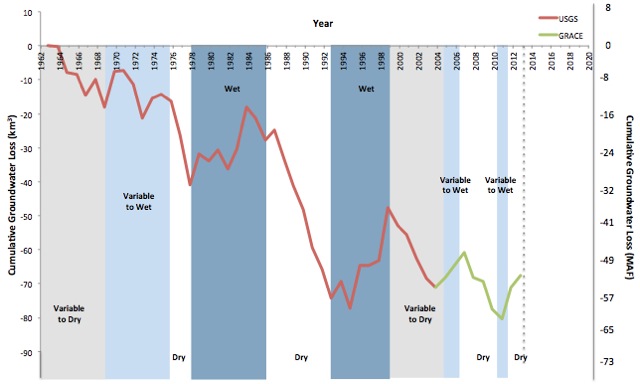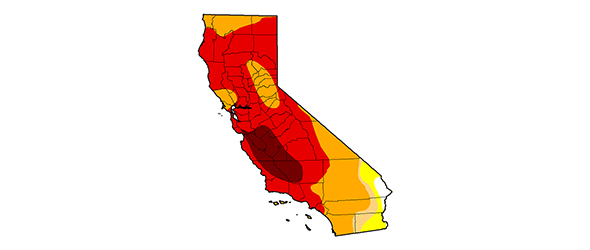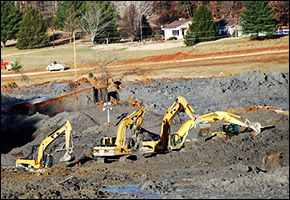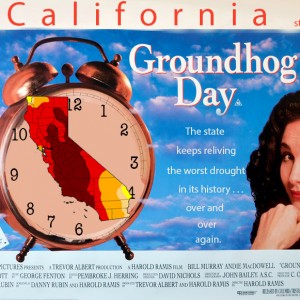California Drought Saps Water Reserves Above and Below Ground, Says Satellite Data
Snow is scarce, reservoirs are approaching bottom, and groundwater is being exhausted in the nation’s most populous state. More than a dozen communities face water shortages in the next 60 to 100 days, and there will be zero water deliveries from the state’s largest canal system this year.
By Brett Walton
Circle of Blue
Trapped in a dry phase among the worst in the last 500 years, California is losing water reserves as if through a sieve, according to satellite data released Monday. The data also show that groundwater, a common safety net in times of drought, is being guzzled unsustainably in the state’s prime farming region, the Central Valley.
Recognizing the perilous situation, the California Department of Water Resources cut anticipated water deliveries on January 31 from the state’s largest canal system to zero for the first time in the project’s 54-year history. The announcement affects thousands of farmers, as well as 24 municipal contractors. The department also requested a reduction in the amount of water that it releases through the Sacramento-San Joaquin Delta, an ecologically fragile area.
Some towns are already on the brink — last week, the California Department of Public Health announced that 17 communities, ranging in size from 39 to 11,000 people, face water shortages in the next 60 to 100 days.
“The big question is really, ‘What’s next?’”
— Jay Famiglietti, director
UC Center for Hydrologic Modeling
From when the current drought began in November 2011 through November 2013, the amount of water stored in the Sacramento-San Joaquin watershed, the state’s largest, and in the Central Valley has dropped by 20 billion cubic meters (5.3 trillion gallons), or two-thirds the volume of Lake Mead, the nation’s largest reservoir.
The recent losses are in addition to the 30 billion cubic meters (7.9 trillion gallons) of water that the state lost from 2003 to 2010 – a volume equal to Lake Mead. Both figures come from analysis of GRACE data by researchers at the UC Center for Hydrologic Modeling at the University of California, Irvine. GRACE is a pair of NASA satellites, launched in 2002, that use changes in the Earth’s gravity to monitor fluctuations in total water storage; that is, the amount held in reservoirs, mountain snowpack, soils, and aquifers.
To put this in perspective, 50 billion cubic meters (13.2 trillion gallons) lost in this region between 2003 and 2013 is more than the entire state’s total annual water withdrawals in 2005 — and almost half of that was lost over the last two years alone. In other words, leading up to November 2013, the diminishment in California’s water reserves represent the worst two-year decline in that state in the 10-year GRACE record.
But water supply conditions in the most populous U.S. state are even more dire than these data suggest.
Thanks to an unrelenting ridge of coastal high pressure that blocked storms from the Gulf of Alaska, California’s drought deepened in the two months since November 2013 — almost no rain or snow has fallen in the state during its wet season, and snowpack is just 15 percent of normal, meaning that there is little snow in the mountains to replenish depleted reservoirs during the spring melt.
From a birds-eye view, however, scientists do not know exactly how much worse the drought has become. GRACE data for December 2013 and January 2014 are not yet available for analysis due to the time required to process the raw numbers, and the next update will not be available until early summer.
Prime the Pump
Historically, California gets through two consecutive dry years by drawing down its reservoirs, according to Jay Lund, director of the Center for Watershed Science at the University of California, Davis. After two drought years, Lund told Circle of Blue, groundwater becomes an essential source.
State data bear this out. Key reservoirs that feed major canal systems are currently at or near record lows for this time of year. Near Sacramento, for instance, towns and mining roads that were inundated when Folsom Lake was created in 1955 are now above the water line, as the reservoir has recently dropped to 17 percent of capacity. Meanwhile, Stanislaus County in the Central Valley approved twice as many new wells last year as in recent years, the Modesto Bee reported.
“Groundwater is difficult to regulate in a drought, because it’s the back-up source that people rely on.”
— Doug Parker, director
California Institute for Water Resources
Modeling done by the U.S. Geological Survey shows groundwater levels dropping sharply in drought years. Researchers at the UC Center for Hydrologic Modeling used those data to demonstrate that the aquifers in the state’s agricultural heart are being used unsustainably.
Numbers from the GRACE satellites and the U.S. Geological Survey reveal a steady downward trend in the amount of water that is held in Central Valley aquifers. The aquifers are used primarily to irrigate the valley’s 1.5 million hectares (3.7 million acres) of farmland, which is half of the state’s total. Even though they are polluted with nitrates, the aquifers also are a water source for many small, impoverished towns.
The aquifers’ decline reflects a longstanding and problematic imbalance in groundwater use — more water is pumped out during the dry years than soaks in during the wet years. In other words, the bank account is steadily being drawn down.
“The big question is really, ‘What’s next?’” said Jay Famiglietti, director of the UC Center for Hydrologic Modeling. “If the drought continues as expected, it will push groundwater levels to potentially disastrous lows.”
Disastrous lows come with a host of repercussions. Famiglietti pointed to several:
- an increase in the cost of pumping water
- a reduction in water quality
- stream depletion
- land subsidence
A USGS study, published in November, argued that land subsidence threatens the structural safety of the Delta-Mendota canal, a major cog. Pumping from below, in other words, may cause the system to crack from above.
State Lacks Groundwater Regulation
State neglect of groundwater is not an oversight – it is inherent to the system. California has no statewide policy on groundwater use, said Doug Parker, director of the California Institute for Water Resources. No reporting requirements; no permits to regulate the amount of water withdrawn.
“Groundwater is difficult to regulate in a drought, because it’s the back-up source that people rely on,” Parker explained to Circle of Blue. “But sometimes drought is good, because it gets people to consider policy changes. Groundwater is what you need to have during a drought, so we want to make sure we’re not using it poorly in wet years.”
Famiglietti told Circle of Blue that the state needs policies that put a brake on groundwater use.
“Unless we enact groundwater-management policies soon,” he added, “our current practice of massive groundwater depletion during times of drought will threaten the sustainability of future water supplies for the entire state.”
Brett writes about agriculture, energy, infrastructure, and the politics and economics of water in the United States. He also writes the Federal Water Tap, Circle of Blue’s weekly digest of U.S. government water news. He is the winner of two Society of Environmental Journalists reporting awards, one of the top honors in American environmental journalism: first place for explanatory reporting for a series on septic system pollution in the United States(2016) and third place for beat reporting in a small market (2014). He received the Sierra Club’s Distinguished Service Award in 2018. Brett lives in Seattle, where he hikes the mountains and bakes pies. Contact Brett Walton










Leave a Reply
Want to join the discussion?Feel free to contribute!